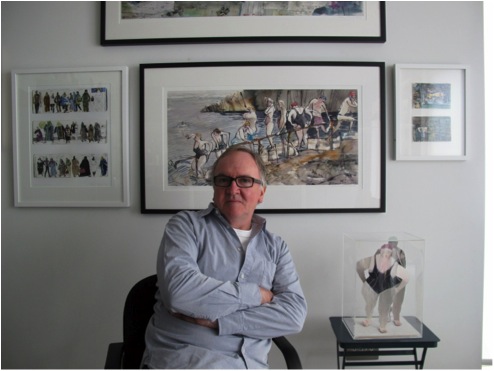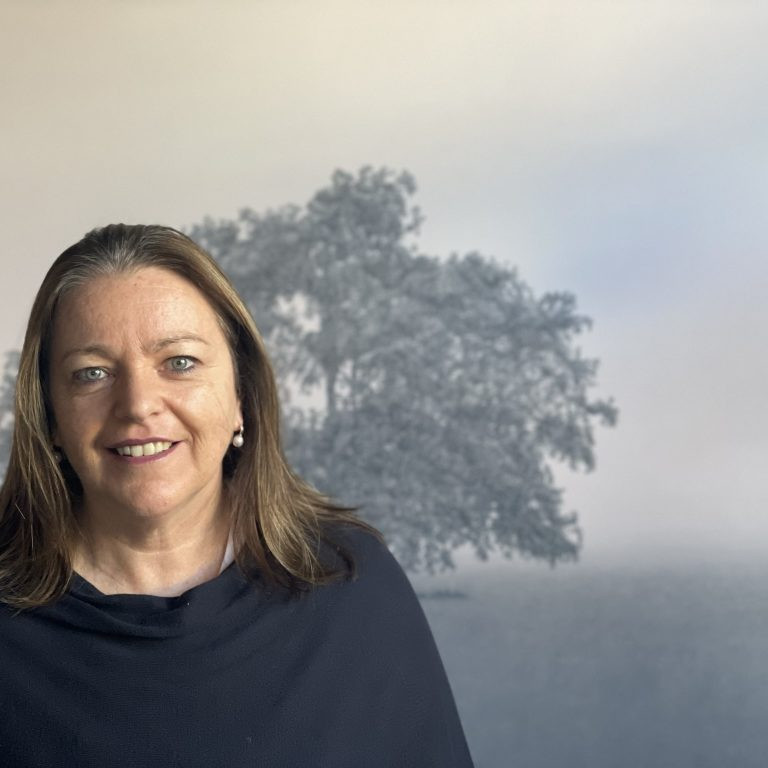John Short Painter - Dublin, Ireland
Sketchbooks are an intricate part of your artwork, can you expand on this?
All through my college years and to date I have used sketchbooks for a variety of functions, the most important one is familiarising myself with the drawing, shapes, foibles and movements of my subjects be they people, birds or animals. I also use them to experiment with arrangements and compositions. In these pages I can experiment with colour and collage. I have always believed that the act of drawing and visualising something means that, however slight, that my idea has become crystallised on paper. That’s really important and I never edit them as the drawings which don’t work out are often the ones that you learn most from. I work with a variety of sizes, shapes and paper surfaces of sketchbooks. They are not regular visual diaries, nor are they meant to be, but places where I record subjects as they unselfconsciously appear in life. At this stage I have many, many volumes and often comb through them for useful fragments in finished paintings back in my studio. I often think of finished paintings as large immediate sketchbook pages.
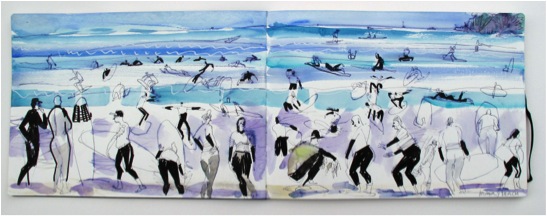
‘Manly Beach’
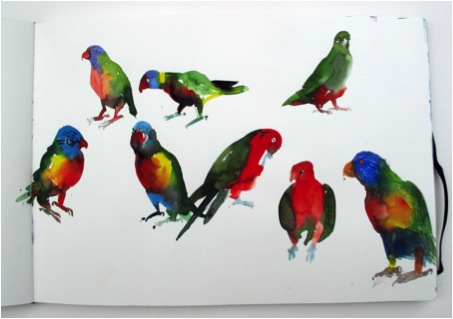
‘Birds’
I also followed a lot of the truly exotic bird life around; a highlight was a flock of pelicans at Noosa in Queensland.
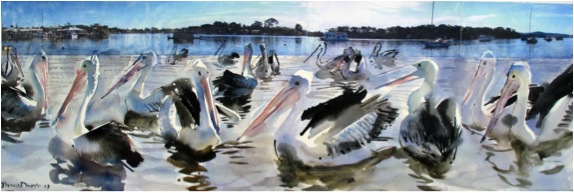
‘Pelicans at Noosa’
Also a series of drawings done during a musical concert in the Hayden Orpheum in Cremorne, a beautifully restored Art Deco movie theatre.
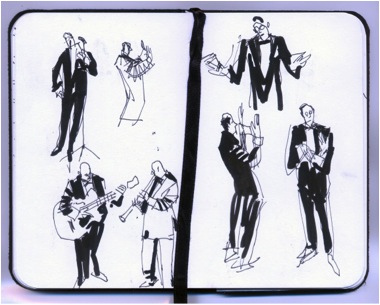
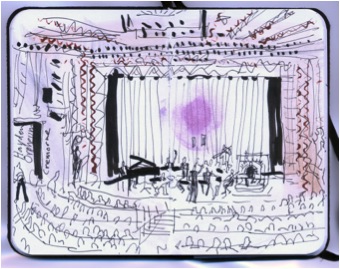
The plan is to return to Australia next July/August to explore and do more now having taken in a lot of potential locations. I bought a beautiful gigantic A3 moleskin watercolour sketchbook in Shanghai which I used specifically for my Australian travels. I also filled a couple of pocket sized sketchbooks.
You have sketchbooks, but what other documentation do you do of your work?
My work methods are fairly simple I will draw my living moving subjects in sketchbooks and use my digital camera for use in recording background locations. Recently I have been working on combining photo transfers (digital images) and ink and watercolour drawings. This has been very interesting technically and I make a lot of use of my camera and colour printer. I have to also keep my website up to date with scanned 2D and photographed 3D works.
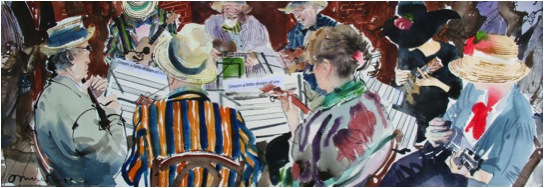
‘Bloomsday, Ukelele Band’
When you do your initial sketches composition is high on your agenda. Can you elaborate on how you get such variation of composition?
When I was a student in the Royal College of Art in London I set Sundays aside for visiting galleries and studying composition and colour in paintings. I have always been a big fan of Degas, Hockney, Bruegel, Singer Sergeant, Utamaro and Sydney Nolan to name a few. It helps to study how others construct effective compositions as well as developing and formulating your own.
How do you manage you work load between teaching, travelling, sketching and time in your studio?
I think the answer to that is to combine a lot of these things. My teaching involves a fair bit of travel and I work in cooperation with a colleague, Tom Kelly, who is a highly experienced photographer. We work together teaching image making (includes drawing, illustration, photography) with visual communication students in Dublin Institute of Technology (DIT) and this has involved a lot of location work, regularly in Morocco and China.
Our teaching method includes us producing work on location with the students and followed by a public exhibition of the results of their work and ours. One of the highlights of this practice was a six week location project with our students and students of Shanghai Institute of Visual Arts documenting the gigantic EXPO world fair in China. Otherwise I work in my studio whenever and as much as I can. I’m lucky as I work relatively fast after a lot of preparation and visual research.
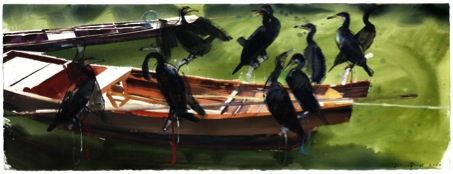
‘Cormorants, China’
Place is very important to your work, you get great inspiration while away. Can you discuss how you combine travel and teaching?
As with the recent trip to Australia for me travelling is always inspiring and it’s not difficult to be inspired and inspire students when on locations abroad. It’s easy to forget how influential these field trips can be for students who often use the wealth of visual research material they collect towards other project work on their return. It must be said that for me it’s very interesting seeing what inspires the students on site also. I’m proud to say that the work we do with the students has been described as a showcase for our School of Art and Design in DIT.
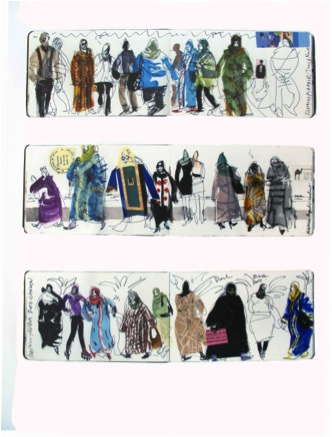
‘Moroccan Sketchbook’
Water is in many of your paintings, can you comment on the mirror effect of painting water?
Reflections and wave patterns are lovely things which are fairly difficult to handle. Water changes so much and the effect of reflected light, colour and shadow can be managed if you can control ink and watercolour allowing them to flow and do what they naturally want to do, what I mean is that they are perhaps the most appropriate and subtle media for this subject. Again it helps if you look at how other artists handle water reflections; the American artist John Singer Sergeant for instance did a series of beautiful watery watercolours of boats in Venice. In watercolour, unlike oil painting, it’s easy to see how it is done. It’s incredibly difficult to do it of course but the trick is to make it look effortless.
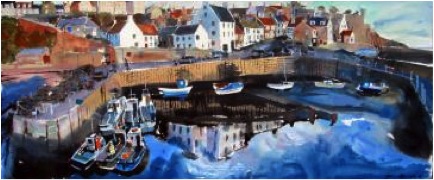
‘Scotland #3’
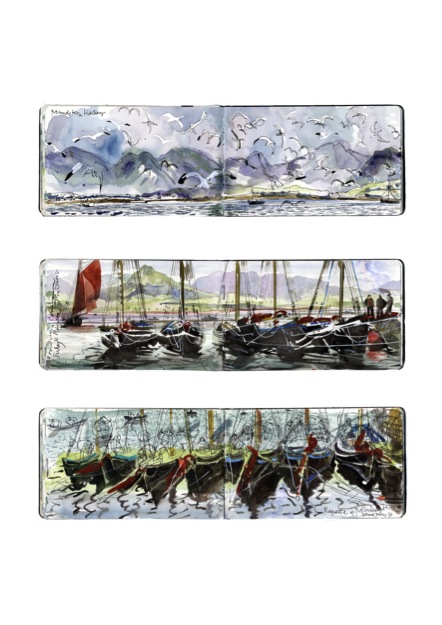
‘West Ireland Sketchbook’
Earlier you had commissions from both newspapers and magazines. How has this work developed the work you do today?
I worked for several years as a freelance illustrator for newspapers and publishers in London and in Dublin and I enjoyed the challenge of each job as they came in. I had no idea what might be asked for subject wise from portraits to editorial, to court room drawings, to food illustrations, to book jackets and posters. It was all very demanding but I certainly learned a lot and was able to successfully work from photo libraries and on site to create material for reproduction. I haven’t done any commissioned illustration for many years now but I still enjoy doing family watercolour portraits as commissions. I certainly could write another article about that whole area.
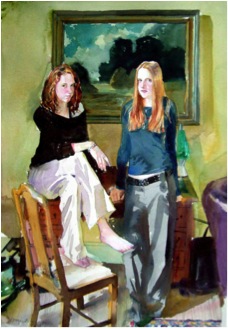
You are the Senior Lecture in Drawing and Image making at the School of Art & Design, at the Dublin Institute of Technology. Can you share one or two pieces of advice that you give your students?
It is all about basics and the basics are the same for Drawing, Illustration, Image making and Photography. It goes without saying that being professional is essential and remembers that the world is endlessly hungry for new and original images and ideas. Make sure that you understand what is required in a brief and anything of yours that your mother likes – tear it up!
Many of your paintings are made into prints can you discuss the decisions that must be made in this process?
A selected and limited amount of my paintings have been successfully reproduced as digital prints, or giclee prints as the process is technically known. It’s a highly faithful reproduction of original artwork which is something that you either like or don’t like however there is no denying the beautiful quality of the printed image. Opinion is clearly divided and some gallery owners and collectors can be very sniffy about them but for me a limited edition print can be much more affordable alternative for a lot of people. The decision to print an edition is something I always discuss with the owner of the original. It is true to say that most sales via the website are prints. To distinguish the original from the print I make a point of reproducing it to a slightly smaller size than the original. They are expensive to produce and you need therefore to consider the edition sizes as well as price. With this kind of printing the print companies charge often by the square centimetre and a once off charge for photographing or scanning.
You do wonderful work capturing the everyday, can you discuss this?
Observing how people move and interact, their body language, their costumes, their shapes and all their imperfections are intensely human and it’s this I find endlessly fascinating and entertaining. In unselfconscious moments people can be very revealing and honest.
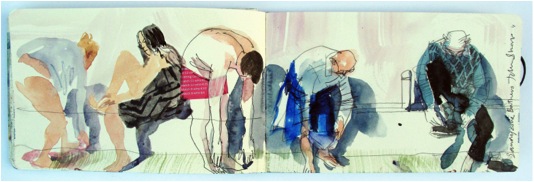
In different locations and cultures the everyday becomes exotic, please discuss?
For me it is like theatre with lives being acted out in similar ways but in different costumes and locations. People do interact and behave in different social ways and have exotic cultures but underneath they are all still people who have their own individual foibles which are unique. Those are the pearls which you have to look for no matter whether you are here looking at bathers in Ireland or Australia, dancers in China or shoppers in Morocco.
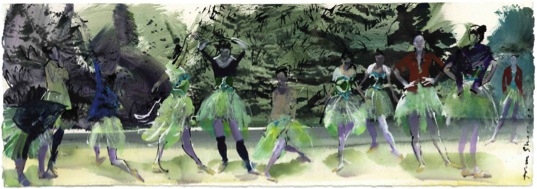
‘Ballet Class in the Park, Shanghai, China’
Discuss the use of current technology in your art?
I am always looking for new ways to change and develop my work, particularly with the technologies available that are developing at a dynamic pace. It’s all highly seductive of course but what you need to understand is that it all has to work for you and your demands. I use digital photography via software and my printer to achieve what I want to do. Right now its photo transfer and combining media in images but I would love to have time to animate drawings, perhaps that is the next thing? I have done some work in 3D drawings and I would like to experiment with some 3D sculptures on a 3D copier.

Can we look at Forty Foot: please explain the name?
Nearby to where we live is a public outdoor bathing place where people swim all year round, summer and winter, I guess for all sorts of reasons, mainly health and life affirming but it’s a real local tradition and has quite understandably become something of a tourist attraction. It’s a natural deep rock pool in Dublin bay which, it is said was named after the Highland regiment 40th of foot who were stationed there in a Napoleonic fort in the 19th century, but its origins are fairly obscure.
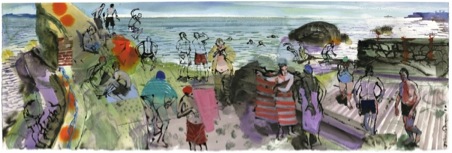
Inspiration?
For a charity fund raising event some years ago I was asked to contribute a few paintings that I put together from sketches I had made of bathers at the Forty Foot. They proved to be very popular and I began to supply prints and more paintings to a local gallery and the combination of my quirky drawings and quirky subjects really struck a cord.
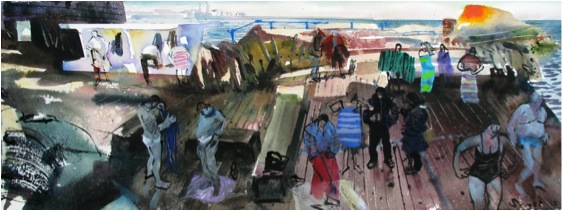
‘Winther Bathers – New Year’
Location?
The specifics of location are really important to my work. They are all places which are accessible and I think that their charm is that aspect and my visions of those places, that’s why I think that the fusion of media with photographic elements and drawing works and is worth developing. After all photographs have a function and drawings have a function in imagery.
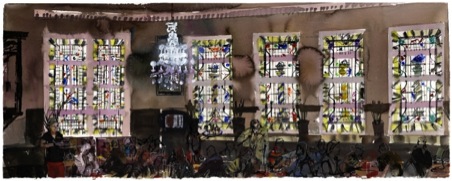
‘Bewleys Café, Dublin, Ireland’
You have also made 3D images can you explain about this work and in particular related to Forty Feet?
I have made a few series of 3D figurative sculptures from packaging card inspired by the simplicity of Picassos’ simple folded card figures. I worked on a series of local bathers and also a series of couples practising ballroom dance moves from a park in Shanghai. This was a new and enjoyable departure from 2D to 3D and as a French friend of mine said, that it must be very interesting for me to walk around my drawings. Working with cheap materials really appealed also, it makes them somehow more honest and to use that word ‘quirky’ again. There is certainly a lot more development work needed on those but so far so good.

Your aim is for your work to look spontaneous and unplanned but this is not really the case. Please expand on this?
Some time ago I ditched the ubiquitous bouncy castle at one of our son’s birthday parties in favour of having the kids all sit individually for small watercolour portraits, which they all got to take home with them in their goody bags. It really was great fun, it’s a bit of a real party trick actually and at one point as I was painting one of my sitters, I was conscious of a boy watching over my shoulder and nearing completion he called the others through to look and said ‘Wow! It starts of crap and then it’s cool’
Actually sounds like a metaphor for my career.
Otherwise…
Giving the impression of spontaneity is important in my work. Being casual and relaxed certainly helps through much practice and draughtsmanship. Often the quickest seemingly throwaway and most immediate use of materials can often capture more than a few too many strokes. Make it look effortless, controlled and well observed.
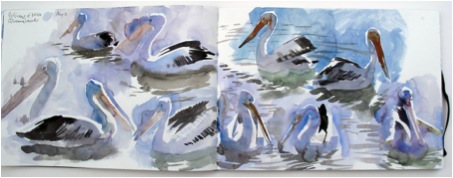
‘Pelicans, Noosa, Australian Sketchbook’
Contact details:
Email: John@johnshort.ie
Website: www.johnshort.ie
John Short, Dublin, Ireland
Interview by Deborah Blakeley, August 2013
Think a colleague or friend could benefit from this interview?
Knowledge is one of the biggest assets in any business. So why not forward this on to your friends and colleagues so they too can start taking advantage of the insightful information the artist has given?
Other artists you may be interested in:


